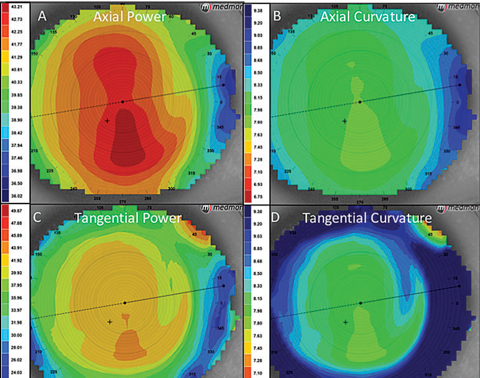 |
| Central corneal thickness, thinnest corneal thickness and corneal volume appeared to correlate with AL in myopic patients in this study. (Photo from different patient) Photo: Maria Walker, OD. Click image to enlarge. |
In light of the worldwide myopia burden, researchers continue to investigate the precise mechanism behind this ocular condition and its subsequent risk factors. With this goal in mind, a new study suggests high myopes’ corneas may have unique structural features, namely smaller curvatures, thicknesses and volumes.
Within 28mm of axial length (AL), the authors also found that changes in corneal parameters showed a refractive compensation effect on myopia. This finding wasn’t detected in extremely high myopic eyes.
“This indicates that 28mm may be the AL threshold for maintaining the ocular mechanical stability,” the authors wrote in their paper.
The cross-sectional study enrolled 299 Chinese patients with high myopia and 266 age- and sex-matched controls. All participants underwent SS-OCT imaging and optical biometry measurements. The investigators considered central corneal thickness, thinnest corneal thickness, corneal volume and anterior, posterior and total corneal curvature. They then correlated these measures with AL based on a multiple linear regression model.
In the high myopes, central corneal thickness, thinnest corneal thickness, corneal volume and anterior, posterior and total corneal curvature were smaller compared with that of controls.
Additionally, central corneal thickness, thinnest corneal thickness and corneal volume showed a continuous decline when compared with AL. On the other hand, total corneal curvature decreased rapidly with AL when AL was less than 26mm, while the slope decreased when AL was between 26mm and 28mm.
Of note: this association wasn’t detected when the AL was longer than 28mm.
“This is likely due to the reasons that highly myopic eyes usually have lower corneal tangent moduli than normal controls; therefore, corneas of high myopic patients are less stiff,” the authors wrote. Moreover, emmetropization may prevent myopic shift, and high myopia may have refractive compensation through the changes of corneal curvature, they added.
Based on multiple linear regression findings, the researchers also found central corneal thickness, thinnest corneal thickness and corneal volume appeared to be tied to AL. However, the investigators didn’t find a correlation between anterior, posterior and total corneal curvature with AL when AL was less than 26mm or between 26mm and 28mm.
These findings not only suggest full consideration be given to the special distribution of corneal curvature for IOL calculations in subjects with high myopia, but they also indicate that more attention should be paid to the pathological changes of the eye in people with ALs greater than 28mm, the authors said.
Further longitudinal studies with larger sample sizes are warranted to test this hypothesis, they added.
Jin G, Liu Z, Wang L, et al. Corneal biometric features and their association with axial length in high myopia. Am J Ophthalmol. December 8, 2021. [Epub ahead of print]. |

